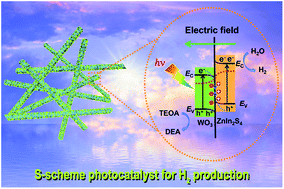H2-production and electron-transfer mechanism of a noble-metal-free WO3@ZnIn2S4 S-scheme heterojunction photocatalyst†
Abstract
Solar-driven hydrogen production can alleviate the ever-growing energy crisis, but developing affordable and efficient photocatalysts is challenging. We here report a noble-metal-free WO3@ZnIn2S4 S-scheme heterojunction photocatalyst with ZnIn2S4 nanosheets vertically growing out of WO3 nanofibers. Due to the difference in work function, ZnIn2S4 donates electrons to WO3 upon their combination and thereby creates an internal electric field (IEF) at their interfaces. Driven by the IEF and bent energy bands, the photogenerated charge carriers of WO3@ZnIn2S4 follow an S-scheme transfer and separation pathway and maintain strong redox ability, as unveiled by in situ X-ray photoelectron spectroscopy (XPS) and time-resolved photoluminescence spectroscopy. Benefiting from the S-scheme electron/hole separation and lower H2-evolution barrier (ΔGH* = −0.36 eV at S sites), the optimized WO3@ZnIn2S4 heterojunction affords a remarkable H2-evolution activity of 8500 μmol h−1 g−1 with an apparent quantum yield of 3.61% at 420 nm, outperforming most photocatalysts with deposition of noble metals.



 Please wait while we load your content...
Please wait while we load your content...